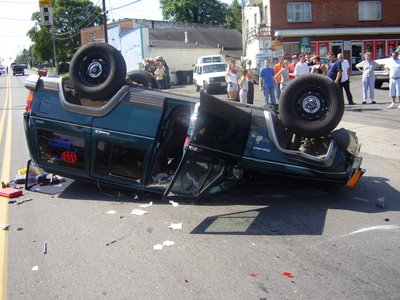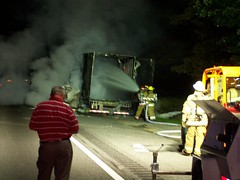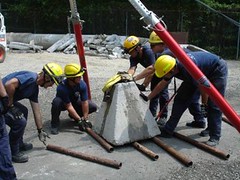Click for more
On Monday, April 6th, members of the Roanoke Fire-EMS Tech Rescue team along with 5 members of the Roanoke County fire-Rescue Department participated in a training exercise on the use of compasses and GPS units. Read More
 The Roanoke Fire-EMS Department has acquired an apartment complex for use in training up until demolition begins to replace the structures with a new complex. The Department has been able to use the complex for training on Rules Of Air Management (ROAM) training and Roof Ventilation Training. The training has been accomplished on duty, rotating crews from the various stations through the training on all three shifts. (Read More and see additional Photos at VAFireNews.com)
The Roanoke Fire-EMS Department has acquired an apartment complex for use in training up until demolition begins to replace the structures with a new complex. The Department has been able to use the complex for training on Rules Of Air Management (ROAM) training and Roof Ventilation Training. The training has been accomplished on duty, rotating crews from the various stations through the training on all three shifts. (Read More and see additional Photos at VAFireNews.com)Scott Graham, Clayton Martin, Brian Conner, Teddy Adkins, Werner VanDamme
and Vince Stover work through a problem in class. (above)
and Jeff Beckner work as a team. (above)
Thanks to Travis Collins for the pictures.
I have been busy recently, I will try my best to get back into the swing of things soon. It always helps when I get stuff submitted, so if you have something to share be my guest.
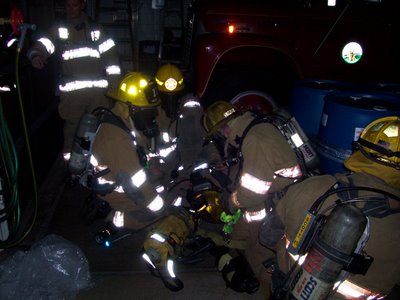 The crew of Ladder 13 train as the Rapid Intervention Team (R.I.T.) at Station 10 tonight. The victim was yours truly and the team working includes Lt. Doug Hurd, Lt. Dean Russell, FF Scott Bradford, and FF Chris Elmore.
The crew of Ladder 13 train as the Rapid Intervention Team (R.I.T.) at Station 10 tonight. The victim was yours truly and the team working includes Lt. Doug Hurd, Lt. Dean Russell, FF Scott Bradford, and FF Chris Elmore.
The Rapid Intervention Team is staged at the scene of structure fires in case the need arises to evacuate one of our own. We practice techniques to remove firefighters as quickly and efficiently as possible. Last week, the crews at Station #2 came out to #10 to practice.
On a historical note, the red engine behind the firefighters is the last completely red truck in Roanoke City. The truck is Tanker 10 and is actually owned by Roanoke Regional Airport. It is also the last Oren in Roanoke City and bears the old Roanoke City seal on its doors, which can be seen in the picture. Thanks to FF Travis Collins for this picture.
 L-R FF Brian Adkins, Captain Marvin Huddleston, and
L-R FF Brian Adkins, Captain Marvin Huddleston, andFF David Ploch survey the damage to one of the vehicles.
Scuba instructor, rescuer imparts life-saving advice – Roanoke.com:
Scuba instructor, rescuer imparts life-saving adviceStop, breathe, think and act; a critical lesson Southwest County resident and scuba diving instructor Chuck Swecker urges his students to follow.
Stop, breathe, think and act; words Swecker, a Roanoke Fire Department first lieutenant, lives by when called into action as a firefighter from Station 13 or as part of the Virginia Department of Fire Programs’ division 6 technical rescue team.
Technorati tags: SCUBA, Roanoke Fire, Roanoke, Chuck Swecker
Here is a picture of the tractor trailer fire on Interstate 81 yesterday. The picture was taken by FF Travis Collins who responded with Roanoke City’s Hazardous Materials Team. The fire was in Roanoke County on I81 Northbound between I581 and Hollins.
Links
including:
malfunctioning furnaces
water heaters
ovens
stoves
gas-fired dryers
clogged chimneys
corroded flue pipes
un-vented supplemental heaters
Below is a list of frequently asked questions:
1. What is carbon monoxide (CO) and how is it produced in the home? Carbon monoxide (CO) is a colorless, odorless, poisonous gas. It is produced by the incomplete burning of solid, liquid, and gaseous fuels. Appliances fueled with natural gas, liquified petroleum (LP gas), oil, kerosene, coal, or wood may produce CO. Burning charcoal produces CO. Running cars produce CO. How many people are unintentionally poisoned by CO? Every year, over 200 people in the United States die from CO produced by fuel-burning appliances (furnaces, ranges, water heaters, room heaters). Others die from CO produced while burning charcoal inside a home, garage, vehicle or tent. Still others die from CO produced by cars left running in attached garages. Several thousand people go to hospital emergency rooms for treatment for CO poisoning.
2. What are the symptoms of CO poisoning?
The initial symptoms of CO poisoning are similar to the flu (but without the fever). They include: Headache Fatigue Shortness of breath Nausea Dizziness Many people with CO poisoning mistake their symptoms for the flu or are misdiagnosed by physicians, which sometimes results in tragic deaths.
3. What should you do to prevent CO poisoning?
Make sure appliances are installed according to manufacturer’s instructions and local building codes. Most appliances should be installed by professionals. Have the heating system (including chimneys and vents) inspected and serviced annually. The inspector should also check chimneys and flues for blockages, corrosion, partial and complete disconnections, and loose connections. Install a CO detector/alarm that meets the requirements of the current UL standard 2034 or the requirements of the IAS 6-96 standard. A carbon monoxide detector/alarm can provide added protection, but is no substitute for proper use and upkeep of appliances that can produce CO. Install a CO detector/alarm in the hallway near every separate sleeping area of the home. Make sure the detector cannot be covered up by furniture or draperies. Never burn charcoal inside a home, garage, vehicle, or tent. Never use portable fuel-burning camping equipment inside a home, garage, vehicle, or tent. Never leave a car running in an attached garage, even with the garage door open. Never service fuel-burning appliances without proper knowledge, skills, and tools. Always refer to the owner’s manual when performing minor adjustments or servicing fuel-burning appliances. Never use gas appliances such as ranges, ovens, or clothes dryers for heating your home. Never operate unvented fuel-burning appliances in any room with closed doors or windows or in any room where people are sleeping. Do not use gasoline-powered tools and engines indoors. If use is unavoidable, ensure that adequate ventilation is available and whenever possible place engine unit to exhaust outdoors.
4. What CO level is dangerous to your health?
The health effects of CO depend on the level of CO and length of exposure, as well as each individual’s health condition. The concentration of CO is measured in parts per million (ppm). Health effects from exposure to CO levels of approximately 1 to 70 ppm are uncertain, but most people will not experience any symptoms. Some heart patients might experience an increase in chest pain. As CO levels increase and remain above 70 ppm, symptoms may become more noticeable (headache, fatigue, nausea). As CO levels increase above 150 to 200 ppm, disorientation, unconsciousness, and death are possible.
5. What should you do if you are experiencing symptoms of CO poisoning? If you think you are experiencing any of the symptoms of CO poisoning, get fresh air immediately. Open windows and doors for more ventilation, turn off any combustion appliances, and leave the house. Call your fire department and report your symptoms. You could lose consciousness and die if you do nothing. It is also important to contact a doctor immediately for a proper diagnosis. Tell your doctor that you suspect CO poisoning is causing your problems. Prompt medical attention is important if you are experiencing any symptoms of CO poisoning when you are operating fuel-burning appliances. Before turning your fuel-burning appliances back on, make sure a qualified serviceperson checks them for malfunction.
6. What has changed in CO detectors/alarms recently?
CO detectors/alarms always have been and still are designed to alarm before potentially life-threatening levels of CO are reached. The UL standard 2034 (1998 revision) has stricter requirements that the detector/alarm must meet before it can sound. As a result, the possibility of nuisance alarms is decreased.
7. How should I install a CO Alarm?
CO alarms should be installed according to the manufacturer’s instructions. CPSC recommends that one CO alarm be installed in the hallway outside the bedrooms in each separate sleeping area of the home. CO alarms may be installed into a plug-in receptacle or high on the wall because CO from any source will be well-mixed with the air in the house. Make sure furniture or draperies cannot cover up the alarm.
8. What should you do when the CO detector/alarm sounds?
Never ignore an alarming CO detector/alarm. If the detector/alarm
sounds: Operate the reset button. Call your emergency services (fire department or 911). Immediately move to fresh air — outdoors or by an open door/window.
9. How should a consumer test a CO detector/alarm to make sure it is working? Consumers should follow the manufacturer’s instructions. Using a test button, some detectors/alarms test whether the circuitry as well as the sensor which senses CO is working, while the test button on other detectors only tests whether the circuitry is working. For those units which test the circuitry only, some manufacturers sell separate test kits to help the consumer test the CO sensor inside the alarm.
10. What is the role of the U.S. Consumer Product Safety Commission
(CPSC) in preventing CO poisoning?
CPSC worked closely with Underwriters Laboratories (UL) to help develop the safety standard (UL 2034) for CO detectors/alarms. CPSC helps promote carbon monoxide safety awareness to raise awareness of CO hazards and the need for regular maintenance of fuel-burning appliances. CPSC recommends that every home have a CO detector/alarm that meets the requirements of the most recent UL standard 2034 or the IAS 6-96 standard in the hallway near every separate sleeping area. CPSC also works with industry to develop voluntary and mandatory standards for fuel-burning appliances.
11. Do some cities require that CO detectors/alarms be installed? On September 15, 1993, Chicago, Illinois became one of the first cities in the nation to adopt an ordinance requiring, effective October 1, 1994, the installation of CO detectors/alarms in all new single-family homes and in existing single-family residences that have new oil or gas furnaces. Several other cities also require CO detectors/alarms in apartment buildings and single-family dwellings.
12. Should CO detectors/alarms be used in motor homes and other recreational vehicles? CO detectors/alarms are available for boats and recreational vehicles and should be used. The Recreation Vehicle Industry Association requires CO detectors/alarms in motor homes and in towable recreational vehicles that have a generator or are prepped for a generator.
Roanoke Fire-EMS encourages all Roanoke residents to practice fire safety steps every day. Remember, fire safety is your personal responsibility and fire prevention precautions DO make a difference! The Fire Prevention Division of the Roanoke Fire-EMS Department offers fireplace safety and/ or home fire safety inspections at no cost. Citizens can call 853-2795 to set up an appointment. Citizens in need can also receive a smoke detector at no cost from Roanoke Fire-EMS Administration, 541 Luck Avenue, Suite 120, Roanoke, VA 24016 or call 853-2327. Visit our website at www.roanokegov.com/fire-ems.
Over the past few years as the HTR team has grown to include most of the disiplines of Technical Rescue. We have members who have assisted with emergencies locally as well as in other States, trained all across the Nation, and some who now teach these disiplines Internationally. Technical Rescue includes Trench Rescue, Confined Space Rescue, Vehicle Rescue, Water Rescue, Rope Rescue, Farm Machinery Rescue, Structural Collapse Rescue, and Wilderness Search Rescue, as well as some others. Roanoke should be proud of the level of care the Roanoke Fire-EMS Department is capable of providing.
The first seventy participants will be allowed to play the part of victims, victims’ family members, and media. This is a great opportunity to participate in the community and test your improvisation skills. You will be given a brief description of your injuries and then expected to play the part accordingly. Brunch will be provided along with Commemorative T-Shirts.
The FAA mandates all airports conduct a full scale exercise once every (3) years to test and train emergency responders in the event of an aircraft accident.
To receive a sign up form please call
(540) 362-1999 or email: rraclivedrill@roanokeairport.com
NOTE: 18 years of age and older may participate
Hey look, you can come play with the ARFF Crew at the Airport. Doesn’t that sound like fun. Best of all it is a C- Shift day. Oh Joy. Maybe I will have a call by then. Huh? You heard me right. I have yet to run a call since I have been back on ARFF, with the exception of the FAA mandated “Quick Dash”. I have been at the ARFF Crew since December of 2004, we ran 2 calls during my time there before being moved to Station 8 for about 5 months in June 2005. I returned to the ARFF crew in October and I have not run an ARFF call since. I should play the lottery. I have run calls while riding on Engine 10, I get to ride E10 once every other cycle or two. This brings a whole new meaning to “The best job in the world” trust me. If my coworkers had a clue they would be lined out the door to get my position. Just don’t tell nobody.
The Roanoke City Council Endorsements have been added as well.
The format of the Local site has changed a bit. In order to keep you all up to date the homepage lists any updates as well as the links to them.
Check out the images and all the other good stuff over at Local 1132.
Includes video links.

Breaking news from The Roanoke Times-Crews rescue workers hurt at treatment plant:
Crews rescue workers hurt at treatment plantTwo construction workers were injured Friday morning in an accident at Roanoke’s Regional Water Pollution Control Plant, authorities said.
According to Scott Shirley, director of wastewater operations for the Western Virginia Water Authority, the workers, employed through a contractor called Fru-Con, were working on the construction of a new pump station. They were standing on a suspended platform in a sloped pit approximately 30 to 40 feet deep.
Shirley said the two workers were using a hose to direct wet concrete when, at about 9:20 a.m., the hose experienced a pressure surge. The force of the surge threw the two workers off balance and they fell approximately five feet to the bottom of the pit.
Both workers were injured, said Roanoke Fire-EMS Battalion Chief Ralph Tartaglia, who was not able to estimate their condition but said one of the workers was ambulatory while the other worker’s injuries were more serious.
L-R Chris Brown, Mark Brown, Jamie Brads, Brian Adkins, Baron Gibson, David Ploch, Becky Smith, Brian Fichtner, Jeff Beckner, Davel Muse, John Willdigg, Trevor Shannon, Matt Dewhirst, David Lucas, Marvin Huddleston, John Sweeney, Dennis Duncan. Kneeling in front L-R Todd Harris, Mark Kesterson, Mark Bailey. By the looks of the picture the Units on Scene were BC-1, RS-1, HTR 6, E-6, E-5, E-11, L-1, L-7, M-6, and M-1 transported 2 patients.
I will put more pictures up on the Local site in the next couple of days as they come in. If you have any, please send them in. Thanks to Kent McIlhany for the pictures.
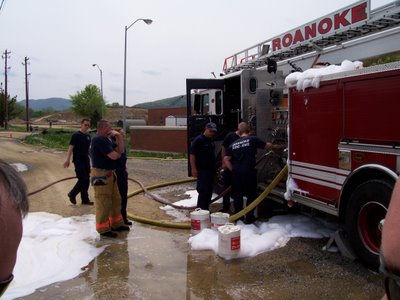
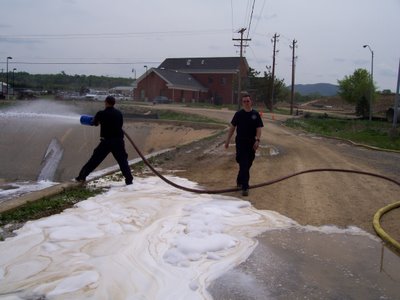 Above you can see Lt. Dean Russell (E10) walking, although I am not sure who is on the line. We were testing a new foam nozzle. It is a task force tip with an aerating attachment on it. This is to replace the old solid tube foam nozzles. I am not sure why we went with the new nozzles, not that I don’t like new equipment to play with. I just do not think the new ones work as well as the old ones. You don’t have the reach that the old ones offer. I have only used the new one once, I look forward to doing more testing on it.
Above you can see Lt. Dean Russell (E10) walking, although I am not sure who is on the line. We were testing a new foam nozzle. It is a task force tip with an aerating attachment on it. This is to replace the old solid tube foam nozzles. I am not sure why we went with the new nozzles, not that I don’t like new equipment to play with. I just do not think the new ones work as well as the old ones. You don’t have the reach that the old ones offer. I have only used the new one once, I look forward to doing more testing on it.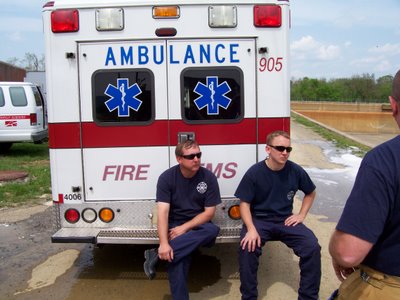 Here is a picture of Lt. Stacy Boothe (E14) on the left and Yours Truly on the right. It isn’t everyday that I get a picture on this blog.
Here is a picture of Lt. Stacy Boothe (E14) on the left and Yours Truly on the right. It isn’t everyday that I get a picture on this blog.




